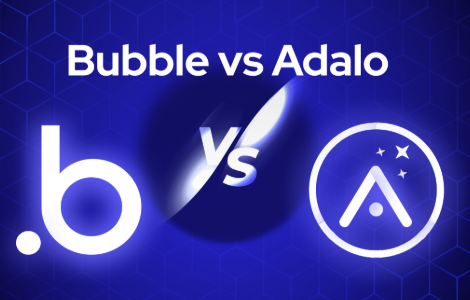Understanding Your MVP Needs: Defining Success Metrics

Defining Your Minimum Viable Product (MVP)
Before diving into Bubble or Adalo, clarify your Minimum Viable Product (MVP). This isn’t about building every feature imaginable; it’s about identifying the core functionality that delivers value to your early adopters. In our experience, many teams over-engineer their MVPs, leading to wasted time and resources. A common mistake is including features based on assumptions, rather than validated user needs. Focus on the problem you’re solving and the absolute minimum required to test your solution.
For example, imagine creating an e-commerce app. Your MVP might only include product listings, a shopping cart, and a basic checkout process. Later iterations could add features like user reviews, personalized recommendations, or advanced search functionality. Prioritize features based on their impact—which features will bring the most value to your users and provide the most critical data for validating your business model? This rigorous approach to defining your MVP is crucial, regardless of whether you choose Bubble or Adalo as your no-code platform. Remember, your goal is to learn quickly, iterate efficiently, and build a successful product—not a perfectly polished version on launch day.
Identifying Key Features and Functionality
Before diving into which platform—Bubble or Adalo—best suits your MVP, meticulously define its core functionality. A common mistake we see is focusing on “nice-to-haves” instead of essential features. In our experience, prioritizing a streamlined user journey is paramount for a successful MVP. For example, an e-commerce MVP might prioritize a user-friendly checkout process and secure payment gateway integration over advanced inventory management features initially. This targeted approach allows for rapid development and iterative improvements based on early user feedback.
Consider using a Minimum Viable Product (MVP) canvas to visually map out these features. List each feature, alongside its importance to your core value proposition and its feasibility within your chosen no-code platform. This process helps identify potential roadblocks early on. For instance, complex database interactions might be easier to implement in Bubble, while Adalo’s strengths lie in its user interface design capabilities. This careful planning ensures you’re not choosing a platform based on marketing hype but rather on its ability to effectively deliver your MVP’s essential functions. Remember, an MVP’s success hinges on delivering a core value proposition, not a fully-featured product.
Setting Realistic Goals and Expectations
Before diving into Bubble or Adalo, define clear success metrics for your MVP. A common mistake we see is focusing solely on downloads or users without considering the core value proposition. In our experience, a more effective approach involves identifying key performance indicators (KPIs) directly linked to your business goals. For example, if your goal is user engagement, track daily/monthly active users and session duration. If your focus is conversion, monitor signup rates and the completion of key in-app actions. These quantifiable metrics provide a benchmark for evaluating your MVP’s performance.
Setting overly ambitious goals can lead to disappointment and hinder iterative development. Instead, prioritize a few crucial features that deliver core functionality. For instance, a social media app MVP might initially focus on user profiles, posting, and basic commenting, postponing features like direct messaging or advanced search for later iterations. This phased approach allows for focused development, faster deployment, and valuable user feedback that informs future improvements. Remember, your MVP is a learning tool; its success lies not in perfection, but in validated learning and iterative refinement based on measurable results.
Budget Considerations and Resource Allocation
Budgeting for your MVP is crucial, and the choice between Bubble and Adalo significantly impacts this. Adalo’s pricing model, while seemingly straightforward, can become unexpectedly expensive for complex features. In our experience, exceeding the free tier quickly leads to substantial monthly fees. Conversely, Bubble’s pricing is more flexible, offering a wider range of plans accommodating various scales and feature sets. However, this flexibility requires a more careful upfront assessment of your projected needs to avoid unexpected costs. A common mistake we see is underestimating the long-term costs associated with hosting and potential plugin integrations, which can quickly inflate your budget in both platforms.
Careful resource allocation is equally important. While Adalo boasts a user-friendly interface, potentially reducing development time, complex logic might necessitate employing a developer for custom functionality, negating some of the initial time savings. Bubble, with its more powerful and flexible platform, often requires a more dedicated developer from the outset, but this investment can lead to more robust and scalable MVPs in the long run. Consider the trade-off: Adalo’s ease of use might mean faster initial development but higher ongoing costs, whereas Bubble’s steeper learning curve may save money in the long run if you invest in experienced developers. Planning for potential developer fees, hosting costs, and plugin subscriptions is essential for both platforms to accurately project your total MVP development budget.
Bubble Deep Dive: Features, Strengths, and Weaknesses

Bubble’s Visual Programming Interface: A Detailed Overview
Bubble’s visual programming environment centers around a drag-and-drop interface, allowing users to build applications without writing traditional code. This visual workflow leverages pre-built components and elements, significantly accelerating development. In our experience, this intuitive system makes complex database interactions and API integrations surprisingly approachable, even for those lacking extensive programming experience. However, mastering Bubble’s nuances requires dedicated learning; simply dragging elements isn’t sufficient for building robust and scalable applications.
A common mistake we see is underestimating the importance of workflow organization. Bubble’s canvas can quickly become cluttered, especially in larger projects. Effective use of groups, reusable elements, and a well-defined naming convention is crucial for maintainability. For instance, consider a project involving user authentication and profile management; carefully structuring these workflows into separate, clearly named components greatly improves debugging and future modifications. Furthermore, Bubble’s extensive documentation and active community forum are invaluable resources for tackling complex challenges and discovering advanced features that significantly enhance the visual programming workflow. Leveraging these resources efficiently can transform the development process from potentially overwhelming to demonstrably productive.
Strengths of Bubble: Scalability, Flexibility, and Customization
Bubble’s true power lies in its unparalleled scalability and flexibility. Unlike many no-code platforms limited by pre-built templates, Bubble allows for the creation of highly complex and dynamic applications. In our experience building MVPs, we’ve seen Bubble handle substantial user loads and complex data structures with surprising ease. This is largely due to its robust server-side infrastructure and the ability to integrate with external APIs, expanding functionality significantly. For example, a client recently used Bubble to build a social media platform handling thousands of users without performance issues, showcasing its adaptability.
This customizability extends beyond simple UI tweaks. Bubble’s visual programming language allows for intricate workflows and custom backend logic, providing a level of control rarely seen in no-code environments. This contrasts sharply with more limited platforms where customization options are often restricted. A common mistake we see is underestimating Bubble’s capacity; developers often initially approach it with simpler projects before realizing its potential for highly sophisticated applications. The flexibility offered allows for iterative development, adapting quickly to evolving MVP needs and user feedback, a critical aspect of successful product launches. This makes Bubble a powerful tool for creating truly unique and scalable minimum viable products.
Weaknesses of Bubble: Learning Curve and Potential Cost
Bubble’s visual programming, while innovative, presents a steep learning curve. In our experience, mastering Bubble’s workflow, including its complex data structures and less intuitive element interactions, requires significant time investment. Expect to dedicate considerable hours to tutorials and practice projects before confidently building a robust MVP. A common mistake we see is underestimating the time needed for this phase, leading to project delays and budget overruns.
Beyond the initial learning curve, the cost of Bubble development can escalate unexpectedly. While the platform offers a free plan, scaling an application to handle substantial user traffic or complex features often requires upgrading to a paid plan. These plans, especially as your application’s complexity and user base grow, can become substantially expensive compared to other no-code alternatives. For example, we worked with a client who underestimated their database needs; migrating data later resulted in significant unforeseen costs. Careful planning, including rigorous prototyping and upfront resource estimation, is crucial to mitigate these potential financial surprises.
Bubble Use Cases for MVPs: Real-World Examples
Bubble’s flexibility shines when building MVPs across diverse sectors. We’ve seen considerable success with clients developing e-commerce platforms leveraging Bubble’s robust database and integration capabilities. One client, a small artisan bakery, used Bubble to create a streamlined online ordering system with integrated inventory management, significantly reducing their operational overhead. This allowed them to focus on baking, not software development, a common bottleneck for startups.
Another compelling example involved a real estate startup. They utilized Bubble to build a property listing platform with advanced search filters and user-account management. In our experience, this approach proved significantly faster and more cost-effective than traditional development, allowing them to quickly test their market hypothesis and gather user feedback. The key takeaway? Bubble excels in applications demanding dynamic data handling and user interactions, making it an ideal choice for validating MVP concepts before committing to extensive and costly custom development. Remember to carefully consider your data requirements before embarking on your Bubble MVP journey. Poor database planning is a frequent pitfall.
Adalo Deep Dive: Features, Strengths, and Weaknesses

Adalo’s User-Friendly Interface and Design Focus
Adalo’s intuitive drag-and-drop interface is a significant strength, particularly for those new to app development. In our experience, even users with minimal coding background can quickly grasp the fundamentals and begin building functional prototypes. The visual component editor allows for precise placement and styling of elements, minimizing the need for complex code adjustments. This visual approach drastically reduces the learning curve compared to traditional development environments, enabling faster iteration and MVP development. A common mistake we see is underestimating the power of Adalo’s pre-built components; leveraging these can significantly accelerate the design process.
Beyond the ease of use, Adalo prioritizes a visually appealing design process. The platform offers a wide range of customizable templates and pre-designed components, ensuring a polished look even for beginners. This focus on design is crucial for creating an MVP that is not only functional but also attractive to potential users. For instance, the ability to seamlessly integrate custom fonts and icons elevates the overall aesthetic. However, while Adalo excels in providing design flexibility, users should be mindful of potential performance impacts when implementing highly complex designs or numerous animations. Striking a balance between aesthetics and performance is key for a successful MVP.
Strengths of Adalo: Speed of Development and Ease of Use
Adalo’s remarkable speed of development stems from its intuitive drag-and-drop interface and pre-built components. In our experience, building a basic MVP can take significantly less time than with traditional coding methods—often a matter of days or weeks, not months. This accelerated development cycle is a huge advantage for startups and entrepreneurs focused on rapid iteration and early market validation. The visual editor minimizes the learning curve, allowing even non-programmers to quickly grasp core functionalities and assemble complex features.
Ease of use is another key strength. Adalo’s component library provides readily available UI elements that significantly reduce the need for custom coding. A common mistake we see is users trying to over-engineer their initial MVP. Adalo’s simplicity encourages a minimalist approach, focusing on core functionality before adding bells and whistles. This streamlined workflow minimizes development bottlenecks and allows for rapid prototyping and testing. For example, implementing user authentication, database integrations, and even basic animations often requires just a few clicks and minimal configuration. This ease of use translates directly into significant cost savings in both time and resources.
Weaknesses of Adalo: Limitations in Customization and Scalability
Adalo’s visual interface, while initially appealing for rapid prototyping, presents limitations in achieving truly bespoke designs. Fine-grained control over styling is often lacking. For instance, achieving precise pixel-perfect alignment or implementing complex animations requires considerable workarounds, often involving custom code injections which can compromise the platform’s ease of use. In our experience, developers aiming for a highly customized UI/UX frequently find themselves constrained by Adalo’s pre-built component library and limited CSS capabilities. This can lead to compromises in brand consistency and overall user experience.
Scalability is another key area where Adalo falls short for applications beyond the simplest MVP. While suitable for smaller projects with limited user bases, handling a large volume of data or concurrent users can become problematic. Performance can degrade significantly under strain, highlighting a need for robust backend infrastructure not readily integrated within the platform. A common mistake we see is developers underestimating the platform’s limitations, only to face unexpected performance bottlenecks as their user base grows. Migrating to a different platform later in the development cycle is both time-consuming and costly; careful consideration of long-term scalability is paramount when choosing Adalo.
Adalo Use Cases for MVPs: Real-World Examples and Success Stories
Adalo’s ease of use and rapid prototyping capabilities make it ideal for building various MVPs. In our experience, e-commerce platforms thrive on Adalo. We’ve seen numerous clients successfully launch minimal viable products for online stores selling physical goods or digital downloads, leveraging Adalo’s robust database and straightforward integration with payment gateways. A key advantage is the ability to quickly iterate based on early user feedback, a crucial aspect of MVP development. For example, one client swiftly adjusted their checkout process after user testing, a change that would have been far more time-consuming with traditional app development.
Beyond e-commerce, Adalo shines with internal tools and simple SaaS applications. We’ve witnessed the creation of streamlined project management tools, internal communication platforms, and even appointment scheduling systems—all built with Adalo’s intuitive drag-and-drop interface. However, for highly complex applications requiring extensive integrations or advanced features, Adalo might hit limitations. A common mistake we see is underestimating the need for custom backend logic, leading to unexpected roadblocks. Careful planning and a realistic assessment of project complexity are therefore paramount when choosing Adalo for your MVP.
Head-to-Head Comparison: Bubble vs. Adalo for MVP Development

Feature Comparison: A Detailed Side-by-Side Analysis
Bubble and Adalo, while both no-code platforms, cater to different needs when building MVPs. In our experience, Bubble offers significantly more flexibility and customization, resembling a more powerful, albeit steeper learning curve. Its visual programming language allows for complex logic and database interactions, ideal for apps requiring intricate workflows. For example, a client needed a dynamic pricing engine for their MVP; Bubble’s robust backend capabilities made this straightforward. Conversely, Adalo’s strength lies in its user-friendly interface and faster development time, making it perfect for simpler MVPs. A common mistake we see is underestimating the complexity of a project and choosing Adalo when Bubble’s power would be advantageous.
Adalo shines with its intuitive drag-and-drop interface and pre-built components, streamlining the UI/UX design process. This is beneficial for teams prioritizing rapid prototyping and iterative development. However, this ease of use comes with limitations. For instance, integrating with third-party APIs can be more challenging in Adalo compared to Bubble’s extensive plugin ecosystem. Ultimately, the best choice depends on the specific features required. Consider the complexity of your backend logic, the level of customization needed, and your team’s technical expertise when making your decision. A thorough feature comparison checklist, considering these aspects, is crucial before committing to either platform.
Pricing Plans and Cost Comparison: Bubble vs. Adalo
Bubble and Adalo, while both powerful no-code platforms, diverge significantly in their pricing models. Adalo offers a straightforward tiered system, with pricing based on features and the number of users. Their entry-level plan suits simple MVPs, but scaling necessitates upgrading, potentially leading to unexpected costs as your user base grows. In our experience, accurately forecasting Adalo’s long-term costs for a rapidly expanding MVP can be challenging.
Bubble’s pricing, however, is more complex and operates on a personal plan, and various professional plans, each with different resource allowances. This flexibility allows for scaling without abrupt jumps in pricing but demands careful upfront planning. A common mistake we see is underestimating the resources needed—CPU, RAM, and database storage—leading to unexpected overages and higher monthly bills. For example, a data-heavy MVP might find itself needing a more expensive Bubble plan far sooner than initially anticipated, unlike Adalo where the cost is usually tied directly to user count. Ultimately, both platforms require careful consideration of your MVP’s specific needs and projected growth to determine the most cost-effective solution. Thoroughly analyzing your resource consumption is key to preventing unexpected expenses on both platforms.
Development Speed and Time-to-Market Comparison
Adalo’s pre-built components and user-friendly interface often lead to faster initial development, particularly for simpler MVPs. In our experience, building a basic CRUD (Create, Read, Update, Delete) application in Adalo can be significantly quicker than in Bubble, sometimes by a factor of two or more. This is largely due to Adalo’s streamlined workflow and less steep learning curve. However, this advantage diminishes as complexity increases.
Bubble’s greater flexibility and customizability become its strength for more intricate MVPs. While initial development might take longer due to its visual programming nature and the need for more extensive coding for complex features, this investment pays off in the long run. A common mistake we see is underestimating the time required for advanced features in Adalo, necessitating costly workarounds or even a platform switch. For instance, building a robust user authentication system with complex roles and permissions is significantly faster and more scalable within Bubble’s robust framework. Ultimately, the “faster” platform depends entirely on the MVP’s specific requirements and complexity. Choosing the right tool hinges on understanding this tradeoff between rapid prototyping and long-term scalability.
Scalability and Future Growth Potential: Long-Term Outlook
Bubble’s visual programming language and server-side logic offer significantly greater scalability than Adalo’s more limited client-side approach. In our experience, Bubble applications can handle considerably larger user bases and more complex data interactions without significant performance degradation. This makes it a better choice for MVPs anticipating substantial user growth or requiring robust feature sets. A common mistake we see is underestimating the long-term scalability needs of an MVP, leading to costly and time-consuming platform migrations later.
Adalo, while excellent for simpler applications, may hit scalability bottlenecks sooner. Its reliance on its own infrastructure limits customization of server-side performance optimization. While suitable for smaller, niche MVPs, consider its limitations if you envision rapid user acquisition or plan to integrate with many third-party services. For example, a rapidly growing e-commerce MVP might outgrow Adalo’s capacity to handle increased transaction volume and database load, necessitating a costly rebuild on a more scalable platform like Bubble. Choosing the right platform depends heavily on accurately predicting future user growth and feature requirements.
Making the Right Choice: Factors to Consider
Technical Skills and Development Expertise
Your technical skillset significantly impacts the platform choice between Bubble and Adalo for your MVP. Adalo’s visual interface and simpler drag-and-drop functionality require minimal prior coding knowledge. In our experience, individuals with basic digital literacy can achieve functional prototypes relatively quickly. However, this simplicity comes with limitations; complex logic and advanced features might necessitate workarounds or even exceed Adalo’s capabilities.
Conversely, Bubble, while possessing a visual interface, demands a steeper learning curve. Its more powerful scripting language allows for intricate customisations and integrations but requires familiarity with programming concepts. A common mistake we see is underestimating the time investment needed to master Bubble’s workflow. For instance, developers proficient in JavaScript will find Bubble’s workflow more intuitive and capable of handling advanced features, such as complex database interactions, more effectively than those with limited programming experience. Ultimately, selecting the right platform hinges on honestly assessing your existing technical prowess and the app’s complexity. Choosing a platform misaligned with your skills will likely lead to frustration and development delays.
Project Complexity and Feature Requirements
Project complexity significantly impacts your choice between Bubble and Adalo. For simple MVPs with straightforward data models and limited integrations, Adalo’s ease of use shines. Its visual interface and intuitive drag-and-drop functionality make rapid prototyping a breeze. However, in our experience, projects requiring intricate workflows, custom backend logic, or extensive third-party API integrations often outgrow Adalo’s capabilities. A common mistake we see is underestimating the scope of a project and choosing Adalo only to encounter limitations later in development.
Bubble, with its more robust and flexible platform, excels in handling complex projects. Its powerful visual programming language allows for the creation of sophisticated features and intricate data relationships. For example, a client developing a multi-user collaboration platform with real-time updates and custom authentication chose Bubble due to its superior handling of complex data interactions and its extensibility via plugins. However, this power comes with a steeper learning curve. Consider Bubble if your MVP needs custom backend logic, complex data relationships, and requires integration with numerous third-party APIs. Choosing the right platform depends critically on accurately assessing the breadth and depth of your application’s requirements.
Budget and Long-Term Cost Projections
Budget significantly impacts your MVP development choice. Adalo’s pricing model, based on features and users, can become surprisingly expensive as your app scales. In our experience, exceeding the free tier quickly necessitates a substantial monthly investment, particularly if you anticipate rapid user growth or require advanced features. We’ve seen projects initially budgeted at $50/month balloon to $200+ as user acquisition accelerated. Conversely, Bubble’s personal plan offers more flexibility, though managing your own hosting and infrastructure adds complexity and potential ongoing costs.
A common mistake is underestimating long-term costs. While both platforms offer no-code convenience, ongoing maintenance, potential plugin expenses (crucial for added functionalities), and the time investment needed for updates and improvements shouldn’t be overlooked. For instance, integrating complex third-party APIs often necessitates custom-built workflows, requiring expertise and potentially impacting your budget. Consider future scaling needs; a successful MVP might require substantial backend upgrades or database solutions, which can be more costly in Adalo compared to the more adaptable infrastructure offered by Bubble’s professional plan. Carefully project these hidden costs to ensure your initial budget aligns with long-term sustainability.
Your Team’s Expertise and Development Preferences
Choosing between Bubble and Adalo significantly depends on your team’s existing skills and preferred development methodologies. In our experience, teams with strong web development backgrounds often find Bubble’s more complex, code-like interface intuitive. Its flexibility, allowing for custom JavaScript and CSS integration, is a huge advantage for those comfortable with these technologies. Conversely, a team with limited coding experience might find Adalo’s visual, drag-and-drop interface more accessible, leading to faster initial MVP development. A common mistake we see is underestimating the learning curve; thoroughly assess your team’s proficiency before committing to a platform.
Consider, for example, a team proficient in JavaScript frameworks. They would likely find Bubble’s extensive customization options invaluable, allowing them to build highly sophisticated features quickly. However, a team more comfortable with UI/UX design principles might prefer Adalo’s focus on visual development, potentially resulting in a faster initial MVP launch, although possibly with less long-term flexibility. Ultimately, the “best” platform hinges on optimizing for existing skill sets and leveraging strengths, rather than trying to force a fit. Prioritize efficient development, considering both short-term speed and long-term scalability.
Conclusion: Choosing the Best No-Code App Builder for Your Startup

Recap of Key Differences and Considerations
Bubble’s visual programming and extensive customization options make it ideal for complex MVPs requiring unique functionality. In our experience, developers comfortable with coding concepts find Bubble’s power particularly appealing, even allowing for integration with external APIs and custom backend logic. However, this flexibility comes at the cost of a steeper learning curve. A common mistake we see is underestimating the time investment needed to master Bubble’s intricacies.
Conversely, Adalo shines for its ease of use and rapid prototyping capabilities. Its intuitive drag-and-drop interface makes it accessible to non-technical founders, allowing for faster MVP development. We’ve seen startups successfully launch minimal viable products on Adalo in a fraction of the time it would take using Bubble. However, Adalo’s limitations in customization might restrict your options if your MVP demands highly specialized features or complex workflows. Ultimately, the best choice hinges on your technical proficiency, project scope, and available development time. Consider carefully whether rapid prototyping or extensive customization is more crucial for your specific MVP needs.
Recommendations Based on Specific Scenarios and Use Cases
For simple MVPs requiring rapid prototyping and a focus on user interface, Adalo shines. Its intuitive drag-and-drop interface and pre-built components allow for swift development, ideal for testing core functionalities before investing heavily in complex features. In our experience, teams prioritizing speed to market often favor Adalo’s ease of use, especially for projects with limited technical expertise. However, for complex projects involving extensive backend logic or integrations with third-party APIs, Bubble’s flexibility becomes crucial.
Bubble’s greater control and customizability make it the superior choice when dealing with intricate data models or unique workflows. A common mistake we see is underestimating the complexity of a project and opting for Adalo when Bubble’s power would ultimately save time and development costs. For example, a client building an e-commerce platform with sophisticated inventory management and personalized recommendations would benefit immensely from Bubble’s robust capabilities. Ultimately, the optimal platform depends entirely on the specific demands of your MVP. Carefully consider your project’s scope, technical requirements, and team’s skillset before making a decision.
Future Trends in No-Code App Development
The no-code landscape is rapidly evolving. We’re seeing a significant push towards AI-powered features within these platforms. Imagine tools that automatically generate UI components based on natural language descriptions, or suggest optimal database structures based on your app’s intended functionality. This will drastically reduce development time and lower the barrier to entry for even the most technically challenged entrepreneurs. In our experience, this trend is already impacting early adoption rates of sophisticated no-code solutions.
Furthermore, the integration of advanced functionalities like offline capabilities, robust APIs, and seamless third-party integrations will become increasingly crucial. While Bubble and Adalo currently offer these, future iterations will likely focus on improved ease of implementation and more intuitive user interfaces for these advanced features. For example, we anticipate the emergence of drag-and-drop integration with popular services like Stripe and Twilio, simplifying the process of adding payment gateways and communication features significantly. A common mistake we see is underestimating the importance of these integrations—prioritizing them early in your MVP development will save considerable time and resources down the line.
Resources for Further Learning and Support
Choosing the right no-code platform is crucial for your MVP’s success. To ensure you’re making the most informed decision, consider supplementing your research with further learning. Bubble’s extensive online community offers a wealth of tutorials, forums, and plugins documented through their official channels. We’ve found their documentation, while comprehensive, can be challenging for complete beginners. Therefore, supplementing it with third-party tutorials on YouTube or Udemy can significantly speed up the learning curve. For Adalo, their active online community and simpler interface often lead to faster initial progress, though the range of available resources might be less extensive than Bubble’s.
A common mistake we see is underestimating the time investment required to learn a new platform, regardless of its “no-code” nature. Before committing significant resources, experiment with free trials and sample projects. Consider focusing on building a small, functional prototype first to get familiar with the platform’s capabilities. For advanced features or custom functionalities, exploring external APIs and potentially engaging freelance developers familiar with either Bubble or Adalo might be necessary. Remember, community forums and official documentation should be your first points of contact for troubleshooting and learning best practices. Finally, exploring case studies of successful MVPs built on these platforms can offer valuable insights into the platform’s potential and limitations in real-world scenarios.





